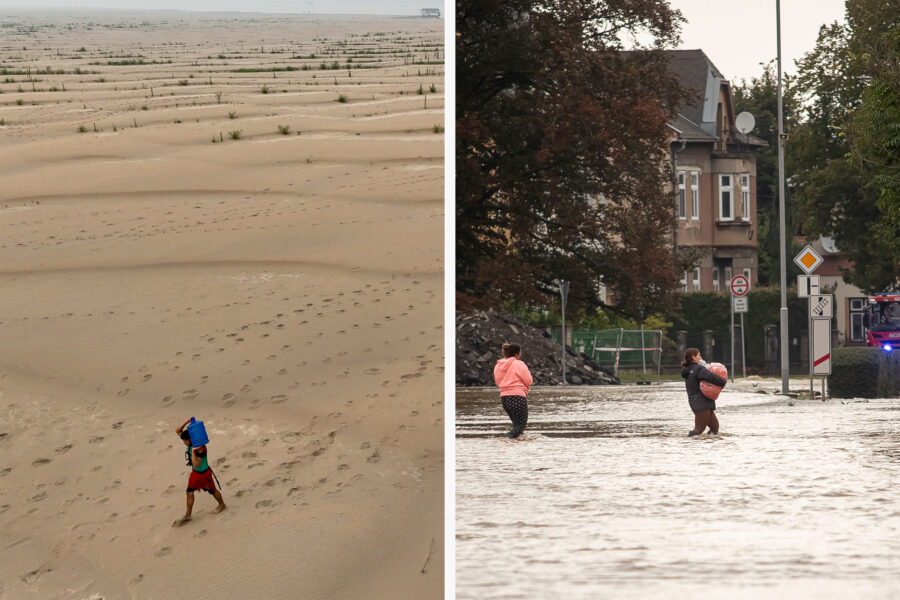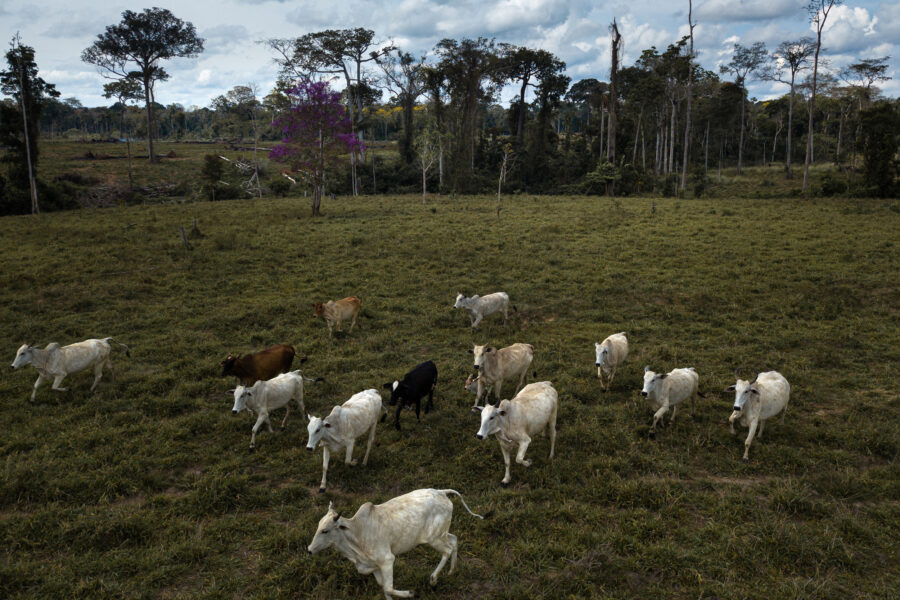Q&A: Near Lake Superior, a Tribe Fights to Remove a Pipeline From the Wetlands It Depends On
This piece is part of our “Behind the Scenes” series, where Kiley Price interviews a fellow ICN reporter to learn more about one of their recent stories and how they reported it.
For centuries, members of the Bad River Band of Lake Superior Chippewa have lived near the shores of the pristine wetlands of northwestern Wisconsin.
Dubbed the “Everglades of the North,” the region boasts thousands of acres of marshes and wild rice beds, thriving populations of sturgeon and rare mammals such as the Canada Lynx. It also contains a section of Line 5, a 30-inch diameter crude oil pipeline that transports up to 540,000 barrels of hydrocarbons per day from Superior, Wisconsin, to Sarnia, Ontario. Built 71 years ago, the structure cuts directly through the Bad River reservation—a point of contention between the tribe and the pipeline’s owner, Canadian company Enbridge.
In 2013, more than a dozen easements granted to the pipeline expired, and the Bad River tribal council voted unanimously not to renew them. Now, the tribe is entangled in an ongoing legal battle with Enbridge to remove the pipeline from the reservation altogether. Enbridge has suggested a reroute that would wrap just south of the reservation and says “our inline pipeline inspection and monitoring programs ensure multiple layers of safety,” but many tribal members still fear the potential fallout of an oil spill or leak into the watershed they rely on.
My colleague Phil McKenna recently visited the reservation to speak to some of the tribal leaders from the Bad River Band about their efforts to shield the reservation from crude oil, which you can read about in a piece he published in August. I asked Phil to tell me about the process behind his reporting and what to keep an eye on as the legal battle continues.
Q: How did you learn about this situation?
I first wrote about the Bad River Band and their efforts to remove the Line 5 pipeline from their reservation in 2017. It was soon after I covered protests against the Dakota Access pipeline in North Dakota near the Standing Rock reservation. This seemed like another situation where a tribe had a strong case against an oil pipeline.
I grew up in Wisconsin a few hours south of Bad River and spent summers in college leading sea kayaking trips around the nearby Apostle Islands of Lake Superior, but I had never visited the reservation. In fact, I’d never heard of the Kakagon and Bad River Sloughs, the vast wetlands known as the “Everglades of the North,” where these two rivers flow into Lake Superior. It is really a hidden gem in the state and the Lake Superior region.
Q: How did you report the story and did anything surprise you?
I contacted tribal leaders earlier this year when I was making plans to visit family in Wisconsin to see if I could extend my stay by a few days and tour the reservation. I didn’t have many meetings set up before I arrived, but once I was there, tribal members were incredibly gracious with their time and in getting me out on the water so I could see the rivers and wetlands firsthand.
I think it is remarkable that you could have a pipeline with easements that expired more than a decade ago, that a landowner has sued to have removed and that a federal court has determined is in trespass, yet is allowed to remain in operation.
Q: Enbridge is seeking to reroute Line 5 around the Bad River reservation with a new, 41-mile section of pipe. How could this also impact the tribe? What happens next that people should keep an eye on?
The tribe is concerned about the environmental impacts associated with simply building the rerouted section of pipe, as it will skirt just south of their reservation and still pass through their watershed. Their concerns include sediment that would be released into the watershed from the project’s construction and the potential to puncture underground aquifers from trenching through wetlands and blasting tunnels beneath rivers and streams.
The far bigger concern, however, is an unlikely but potentially catastrophic oil spill from the rerouted pipeline into the surrounding environment. Such a spill would be hard to clean up and could have devastating and long-lasting impacts on the surrounding wetlands, including the wild rice beds that are a pillar of tribal culture and play a key role in the community’s food supply.
A federal judge ruled last year that Enbridge is trespassing on the reservation and gave the company until 2026 to remove their existing pipeline from the reservation. Enbridge has appealed the decision and a ruling by the Seventh Circuit Court of Appeals is anticipated in the coming months.
The U.S. Army Corps of Engineers is currently considering Enbridge’s proposed reroute. The tribe is calling for the Army Corps to conduct a more thorough environmental review of the project before making any decision on whether to grant a permit for the new section of pipe.
More Top Climate News
A government initiative in the United Kingdom will provide 57 million pounds ($75 million) in funding for researchers to explore solar geoengineering projects—among the largest single investment made in this technique to date, Christopher Flavelle and David Gelles report for The New York Times. Led by the Advanced Research and Invention Agency, the program will support research and testing for several strategies that aim to cool the Earth by reflecting sunlight back into space. Critics of this approach are concerned that intentionally altering Earth’s processes could have unexpected consequences, and focusing on geoengineering could distract countries from reducing their emissions, an issue I wrote about in March.
A month’s worth of rain has fallen across Central Europe over the past week, triggering widespread floods that have killed at least 19 people so far, Niamh Kennedy reports for CNN. The deluge has impacted Austria, Romania, Poland, the Czech Republic and Hungary. Experts say climate change likely contributed to the intensity of these floods, which have left hundreds of thousands of people in urban areas without hot water or electricity.
The U.S. Fish and Wildlife Service is seeking to remove remaining protections for gray wolves under the Endangered Species Act, calling the species’ rebound one of the “biggest success stories” of the wildlife law in a legal brief. If approved, the move could “open the door for hunting to resume in the Great Lakes region after it was halted two years ago under court order,” writes Matthew Brown for The Associated Press. The region hosts a stable population of more than 4,000 wolves, but environmentalists are concerned that removing protections would cause those numbers to drop if hunting ramps up.
Meanwhile, a new joint investigation by Grist and High Country News found that land on nearly 80 Indigenous reservations across a number of states is used to support non-tribal public schools, hospitals and prisons. The article, reported by Anna V. Smith and Maria Parazo Rose, dives into the myriad ways that non-Indigenous people benefit from resources on tribal lands, and how some tribes have to pay states to lease areas for grazing and agriculture within their own reservations.
More than 5,000 firefighters are battling the wildfires roaring through northern Portugal. Officials say the infernos are to blame for at least seven deaths, Jon Henley reports for The Guardian. Hot, dry conditions are making it difficult to contain the flames, an increasingly common problem with climate change.
About This Story
Perhaps you noticed: This story, like all the news we publish, is free to read. That’s because Inside Climate News is a 501c3 nonprofit organization. We do not charge a subscription fee, lock our news behind a paywall, or clutter our website with ads. We make our news on climate and the environment freely available to you and anyone who wants it.
That’s not all. We also share our news for free with scores of other media organizations around the country. Many of them can’t afford to do environmental journalism of their own. We’ve built bureaus from coast to coast to report local stories, collaborate with local newsrooms and co-publish articles so that this vital work is shared as widely as possible.
Two of us launched ICN in 2007. Six years later we earned a Pulitzer Prize for National Reporting, and now we run the oldest and largest dedicated climate newsroom in the nation. We tell the story in all its complexity. We hold polluters accountable. We expose environmental injustice. We debunk misinformation. We scrutinize solutions and inspire action.
Donations from readers like you fund every aspect of what we do. If you don’t already, will you support our ongoing work, our reporting on the biggest crisis facing our planet, and help us reach even more readers in more places?
Please take a moment to make a tax-deductible donation. Every one of them makes a difference.
Thank you,
David Sassoon
Founder and Publisher
Vernon Loeb
Executive Editor
Share this article
Disclaimer: The copyright of this article belongs to the original author. Reposting this article is solely for the purpose of information dissemination and does not constitute any investment advice. If there is any infringement, please contact us immediately. We will make corrections or deletions as necessary. Thank you.







